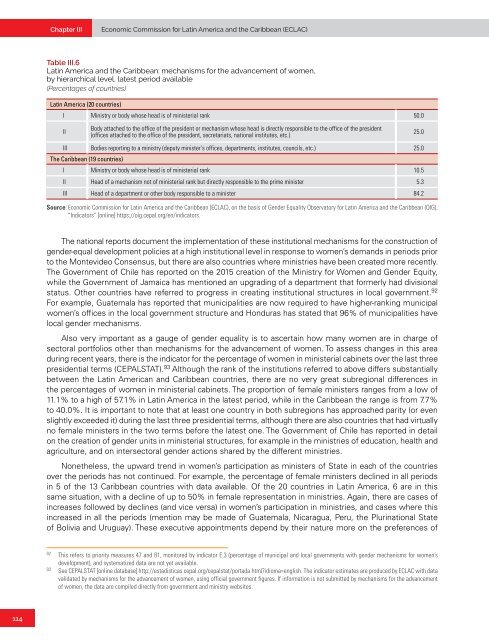Draft first regional report on the implementation of the Montevideo Consensus on Population and Development
This draft report seeks to give an account of progress in the implementation of the priority measures of the Montevideo Consensus on Population and Development in the region, as well as the differences between countries in terms of the degree of implementation. By highlighting relevant national experiences, it also seeks to facilitate the exchange of good practices among countries so that they can benefit from each other in their efforts to advance the implementation of the actions of the Montevideo Consensus.
This draft report seeks to give an account of progress in the implementation of the priority measures of the Montevideo Consensus on Population and Development in the region, as well as the differences between countries in terms of the degree of implementation. By highlighting relevant national experiences, it also seeks to facilitate the exchange of good practices among countries so that they can benefit from each other in their efforts to advance the implementation of the actions of the Montevideo Consensus.
Create successful ePaper yourself
Turn your PDF publications into a flip-book with our unique Google optimized e-Paper software.
Chapter III<br />
Ec<strong>on</strong>omic Commissi<strong>on</strong> for Latin America <strong>and</strong> <strong>the</strong> Caribbean (ECLAC)<br />
Table III.6<br />
Latin America <strong>and</strong> <strong>the</strong> Caribbean: mechanisms for <strong>the</strong> advancement <strong>of</strong> women,<br />
by hierarchical level, latest period available<br />
(Percentages <strong>of</strong> countries)<br />
Latin America (20 countries)<br />
I Ministry or body whose head is <strong>of</strong> ministerial rank 50.0<br />
II<br />
Body attached to <strong>the</strong> <strong>of</strong>fice <strong>of</strong> <strong>the</strong> president or mechanism whose head is directly resp<strong>on</strong>sible to <strong>the</strong> <strong>of</strong>fice <strong>of</strong> <strong>the</strong> president<br />
(<strong>of</strong>fices attached to <strong>the</strong> <strong>of</strong>fice <strong>of</strong> <strong>the</strong> president, secretariats, nati<strong>on</strong>al institutes, etc.)<br />
III Bodies <str<strong>on</strong>g>report</str<strong>on</strong>g>ing to a ministry (deputy minister’s <strong>of</strong>fices, departments, institutes, councils, etc.) 25.0<br />
The Caribbean (19 countries)<br />
I Ministry or body whose head is <strong>of</strong> ministerial rank 10.5<br />
II Head <strong>of</strong> a mechanism not <strong>of</strong> ministerial rank but directly resp<strong>on</strong>sible to <strong>the</strong> prime minister 5.3<br />
III Head <strong>of</strong> a department or o<strong>the</strong>r body resp<strong>on</strong>sible to a minister 84.2<br />
Source: Ec<strong>on</strong>omic Commissi<strong>on</strong> for Latin America <strong>and</strong> <strong>the</strong> Caribbean (ECLAC), <strong>on</strong> <strong>the</strong> basis <strong>of</strong> Gender Equality Observatory for Latin America <strong>and</strong> <strong>the</strong> Caribbean (OIG),<br />
“Indicators” [<strong>on</strong>line] https://oig.cepal.org/en/indicators.<br />
25.0<br />
The nati<strong>on</strong>al <str<strong>on</strong>g>report</str<strong>on</strong>g>s document <strong>the</strong> implementati<strong>on</strong> <strong>of</strong> <strong>the</strong>se instituti<strong>on</strong>al mechanisms for <strong>the</strong> c<strong>on</strong>structi<strong>on</strong> <strong>of</strong><br />
gender-equal development policies at a high instituti<strong>on</strong>al level in resp<strong>on</strong>se to women’s dem<strong>and</strong>s in periods prior<br />
to <strong>the</strong> M<strong>on</strong>tevideo C<strong>on</strong>sensus, but <strong>the</strong>re are also countries where ministries have been created more recently.<br />
The Government <strong>of</strong> Chile has <str<strong>on</strong>g>report</str<strong>on</strong>g>ed <strong>on</strong> <strong>the</strong> 2015 creati<strong>on</strong> <strong>of</strong> <strong>the</strong> Ministry for Women <strong>and</strong> Gender Equity,<br />
while <strong>the</strong> Government <strong>of</strong> Jamaica has menti<strong>on</strong>ed an upgrading <strong>of</strong> a department that formerly had divisi<strong>on</strong>al<br />
status. O<strong>the</strong>r countries have referred to progress in creating instituti<strong>on</strong>al structures in local government. 92<br />
For example, Guatemala has <str<strong>on</strong>g>report</str<strong>on</strong>g>ed that municipalities are now required to have higher-ranking municipal<br />
women’s <strong>of</strong>fices in <strong>the</strong> local government structure <strong>and</strong> H<strong>on</strong>duras has stated that 96% <strong>of</strong> municipalities have<br />
local gender mechanisms.<br />
Also very important as a gauge <strong>of</strong> gender equality is to ascertain how many women are in charge <strong>of</strong><br />
sectoral portfolios o<strong>the</strong>r than mechanisms for <strong>the</strong> advancement <strong>of</strong> women. To assess changes in this area<br />
during recent years, <strong>the</strong>re is <strong>the</strong> indicator for <strong>the</strong> percentage <strong>of</strong> women in ministerial cabinets over <strong>the</strong> last three<br />
presidential terms (CEPALSTAT). 93 Although <strong>the</strong> rank <strong>of</strong> <strong>the</strong> instituti<strong>on</strong>s referred to above differs substantially<br />
between <strong>the</strong> Latin American <strong>and</strong> Caribbean countries, <strong>the</strong>re are no very great sub<str<strong>on</strong>g>regi<strong>on</strong>al</str<strong>on</strong>g> differences in<br />
<strong>the</strong> percentages <strong>of</strong> women in ministerial cabinets. The proporti<strong>on</strong> <strong>of</strong> female ministers ranges from a low <strong>of</strong><br />
11.1% to a high <strong>of</strong> 57.1% in Latin America in <strong>the</strong> latest period, while in <strong>the</strong> Caribbean <strong>the</strong> range is from 7.7%<br />
to 40.0%. It is important to note that at least <strong>on</strong>e country in both subregi<strong>on</strong>s has approached parity (or even<br />
slightly exceeded it) during <strong>the</strong> last three presidential terms, although <strong>the</strong>re are also countries that had virtually<br />
no female ministers in <strong>the</strong> two terms before <strong>the</strong> latest <strong>on</strong>e. The Government <strong>of</strong> Chile has <str<strong>on</strong>g>report</str<strong>on</strong>g>ed in detail<br />
<strong>on</strong> <strong>the</strong> creati<strong>on</strong> <strong>of</strong> gender units in ministerial structures, for example in <strong>the</strong> ministries <strong>of</strong> educati<strong>on</strong>, health <strong>and</strong><br />
agriculture, <strong>and</strong> <strong>on</strong> intersectoral gender acti<strong>on</strong>s shared by <strong>the</strong> different ministries.<br />
N<strong>on</strong>e<strong>the</strong>less, <strong>the</strong> upward trend in women’s participati<strong>on</strong> as ministers <strong>of</strong> State in each <strong>of</strong> <strong>the</strong> countries<br />
over <strong>the</strong> periods has not c<strong>on</strong>tinued. For example, <strong>the</strong> percentage <strong>of</strong> female ministers declined in all periods<br />
in 5 <strong>of</strong> <strong>the</strong> 13 Caribbean countries with data available. Of <strong>the</strong> 20 countries in Latin America, 6 are in this<br />
same situati<strong>on</strong>, with a decline <strong>of</strong> up to 50% in female representati<strong>on</strong> in ministries. Again, <strong>the</strong>re are cases <strong>of</strong><br />
increases followed by declines (<strong>and</strong> vice versa) in women’s participati<strong>on</strong> in ministries, <strong>and</strong> cases where this<br />
increased in all <strong>the</strong> periods (menti<strong>on</strong> may be made <strong>of</strong> Guatemala, Nicaragua, Peru, <strong>the</strong> Plurinati<strong>on</strong>al State<br />
<strong>of</strong> Bolivia <strong>and</strong> Uruguay). These executive appointments depend by <strong>the</strong>ir nature more <strong>on</strong> <strong>the</strong> preferences <strong>of</strong><br />
92<br />
This refers to priority measures 47 <strong>and</strong> 81, m<strong>on</strong>itored by indicator E.3 (percentage <strong>of</strong> municipal <strong>and</strong> local governments with gender mechanisms for women’s<br />
development), <strong>and</strong> systematized data are not yet available.<br />
93<br />
See CEPALSTAT [<strong>on</strong>line database] http://estadisticas.cepal.org/cepalstat/portada.html?idioma=english. The indicator estimates are produced by ECLAC with data<br />
validated by mechanisms for <strong>the</strong> advancement <strong>of</strong> women, using <strong>of</strong>ficial government figures. If informati<strong>on</strong> is not submitted by mechanisms for <strong>the</strong> advancement<br />
<strong>of</strong> women, <strong>the</strong> data are compiled directly from government <strong>and</strong> ministry websites.<br />
114


















